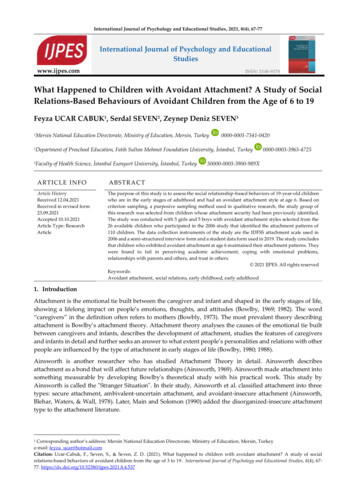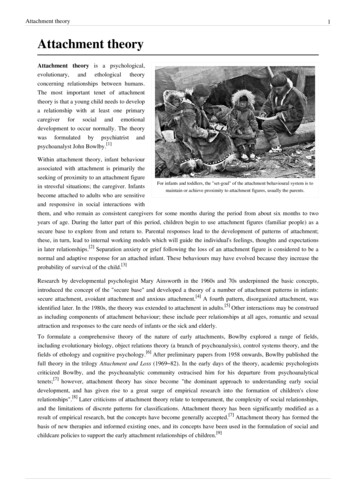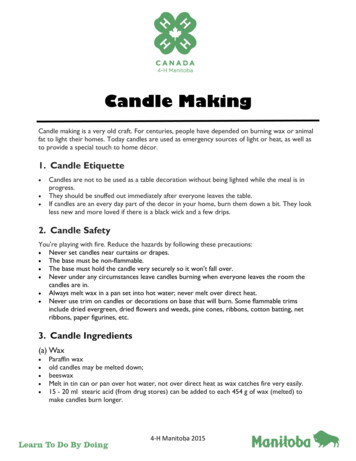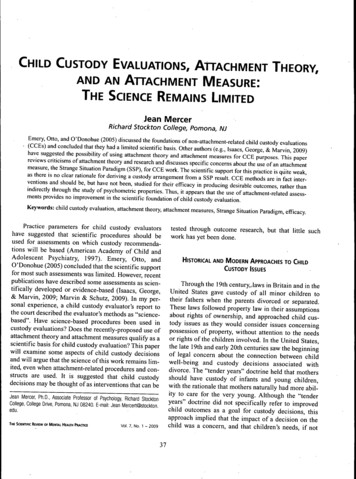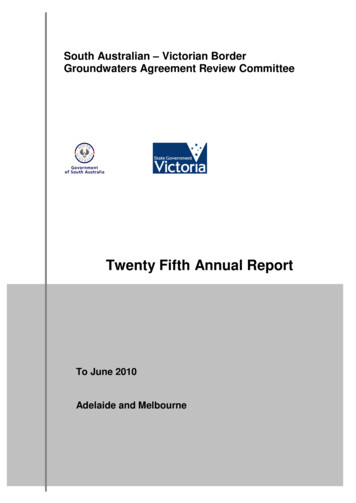
Transcription
Attachment
Presenter’s NotesThe Attachment Teaching Kit Includes: “Attachment” Presentation “Needs versus Wants” Game - Includes facilitator instructions and laminated participant cards. “Understanding Your Childs Feelings” Presentation “ Baby Cues” Activity (13 laminated cards) “Building a Secure Attachment for Your Baby” – Circle of Security (handout) “10 Things your baby wants you to know” – Attachment Network of Manitoba (handout)Optional Resources Additional Activities/Discussion (Trust vs Mistrust, Attachment Across Cultures: “Babies”) “Parenting Reflection” “Self-Care Reflection” Aulneau Centre BrochureFacilitators: If you have questions regarding information contained in this kit please contact :Aulneau CentrePhone: 204 204-987-7090Email: admin@aulneau.comImportant:This kit includes general information about Attachment and primarily focuses on how parents can sensitivelyrespond to their baby. If parents have concerns about their connection or developing relationship with theirbaby or coping with their baby’s/children’s feelings they should contact their health care provider for anassessment and support.
It’s a Matter of Survival.
Ask participants: What would happen if your baby was left in the woods.what wouldher chances of getting out of the forest be (survival rate)? Infant? 0% (unless another human found them)Toddler? Maybe 5% (they might wander out but not likely)School age child? Better chance, maybe 10-20%Adolescent? A much greater chance, 50%Babies cannot survive without us. Babies/children depend on adults to keep them safeand alive. We must know how and when to feed them, shelter them, comfort themand protect them.Even when your baby is not in danger but is feeling stressed, your childneeds you/caregiver to: Help them feel safe and secure Deal with their feelings Manage their environmentAttachment is a matter of life or death for babies!
What is Attachment?
What is Attachment? Attachment is a an emotional bond between your baby andyou/primary caregiver that provides safety, support,comfort and pleasure. The parent/child relationship is the first and most importanttype of attachment which starts before birth and continuesto develop throughout the lifespan. Attachment is not something that parents do to theirchildren it is something that children and parents createtogether, as they learn to read and understand each other’scues. Babies develop a strong attachment to one person but theycan form attachments with several people.
Still Face Experiment
Still Face Experiment (double click on icon)IMPORTANT: Prior to showing the video or having a discussion, understand that this video can beupsetting to some parents and ensure that you let parents know that the mother and baby have ahealthy relationship and attachment. This “situation” was a one-time event and will not have anegative effect on the child. Remember it matters what parents do most of the time, no one is perfect!Ask Participants: What did the mother do in these pictures?1. At first, the mother was interacting with the baby; it was loving and playful and mother and baby wereresponding to each other and in sync.2. Then the mother became still and did not express any emotion or respond to the baby.3. The mother, after one minute, stopped the still face and interacted with and responded with her baby bytouching and talking in a comforting and positive way.Ask Participants: What did the baby do?1.The baby interacted back and forth with the mother reading mother’s cues, showing laughter, smiles, andenjoyment.2.When the mother used the still face, the baby tried to cue her to respond by smiling, pointing, reachingout etc. The baby became distressed and used negative emotions, turned away, felt stress, cried to gether mom’s attention and response.3.After the mother stopped the still face, the baby quickly feels relief and reaches out to mom with handsand smiles. Mom and baby are interacting and in sync again.Ask Participants: What do you think would happen if the mother: responds most (all) of the time to her baby? does not respond any of the time to her baby? responds only some of the time to her baby?Share With Participants: How you as a parent respond to your baby’s (attachment) needs can influence howyour child learns to feel, think and behave.
Attachment lasts a lifetime.Babies/Children with a secureattachment: Enjoy more happiness withparents Feel less anger at their parents Trust the people they love Have higher self-esteem Get along better with siblings andothers Know how to be kind to thosearound them Are able to solve problems Trust that good things will cometheir way
Secure Attachment A secure attachment ensures that your child will feelsecure, understood, learn to trust and know they cancount on you! Babies have an inborn instinct to attach: to reach out toa specific person who will comfort, protect and helporganize their feelings. When there is a secure attachment your child will followtheir inborn curiosity and explore their environmentwhen they feel safe to do so. Having a secure attachment, allows your child’s growingbrain to develop a feeling of safety that results ineagerness to learn, healthy self-awareness, trust, andempathy.
Sensitive Responding to Baby’s Cues
CuesBabies use signals or cues to let parents know what they need. Crying is typically the first cueinfants will use to keep their mothers/caregivers focused on them when they need care.If we respond to their cues with sensitivity, promptly and effectively, they feel understood anddevelop secure attachment.Calming Baby – video/slides (Watch video by double clicking right of arrow)Ask Participants: How does the mother respond to the baby when the baby is cries? Does sheunderstand what the baby is telling her?Answer: Mom is aware that her baby is upset and picks him up to offer support and a feeling ofcomfort. She watches his reaction. Baby continues to cry and fuss. Mom changes her position,she rocks baby and sooths him with a calm, quiet voice. Baby starts to settle. This interactionbetween mom and baby continues until Baby is settled.Ask Participants: What cues does your baby use to interact with you and get your attention?Answer: Encourage participants to share before providing list. Crying, eye contact, arching back, smiling, cooing, fists curled, screeching, clingy, pointing,trying to be close, rooting, rubbing eyes, reaching. etc. Babies develop many cues to have their needs met. As your baby gets older, you will be ableto figure out more easily what they want and how to comfort them.
Insecure AttachmentBabies/children with an insecure attachment: Feel not worthy of love of their parents and others Less able to give & receive love and affection Poorer peer interactions Lower self esteem Higher levels of aggression (bullies) Problems controlling angerIn severe cases an insecure attachment disorder can developand these children are more at risk for increased mentalhealth issues and suicidal risks.
Insecure Attachment Insecure attachment happens when a child cannot rely on a parent tomeet his/her needs. If a parent/caregiver repeatedly responds to the child’s needs and distressby becoming upset, ignoring, ridiculing or by being unavailable andunpredictable, children will develop an insecure attachment. Children will learn to have their needs met in ways that are unhealthy andnegative.o Some children will exaggerate their behavior to get their parentsattention. i.e. uncontrollable crying over small issues like not playingwith a toy, arching back/stiff when picked up for diaper change.o Some children will withdraw or hide emotions when they need theirparent’s attention i.e. not crying or pulling away from parent whenparent picks them up after a bad fall. Insecure attachment can be repaired. A first step for parents and childrenin these patterns of miscommunication, is for parents to developawareness of what their child needs and learn strategies to meet thoseneeds in a consistent, caring and responsive way.
Insensitive Responding to Baby’s Cues
Insensitive Responding to Baby’s CuesFacilitator: Show participants the “Scaring Alex” video or handout andthen discuss the questions below. Watch the video ahead if using slides tolet participants know how the dad is behaving (content below also).Ask Participants: How did the dad interact with the child? Do you think thedad understood what his child was telling him? Did he listen? What do youthink would happen if this kind of interaction happened regularly?Answer: The dad laughed at the child when he was scared and crying hard.The dad said he was sorry and comforted the baby by touching. The babysettled fairly quickly. The dad then repeated the action again scaring the childwith more laughing and again saying he was sorry. The child criedimmediately and louder and he was hard to settle even with the dad’s touch.The dad’s actions and words do not match. The second time the child seemedanxious and less trusting.If this type of behaviour continued, the baby would learn not to trust the dad orother caregivers. The child may try to get the dad to meet his needs by acting outor withdrawing (appear unaffected). Neither response is healthy for baby feelingsecure and safe and could lead to an insecure attachment.
Miscues: Misleading Signals(Double click right of arrow to play video)
MiscuesMiscues are misleading signals that a child will use to communicate when they have an insecureattachment and have learned not to trust that adults will recognize or meet their needs.Facilitator: (Doubleclick to the right of the arrow to play the “Simpsons” video). Show participantsthe video and then discuss the questions below.Ask Participants: How does Lisa feel about her relationships at school? In the beginning, what doesMarge teach her to do about her feelings? To share them honestly, or to cover them up and pretendto be happy? Do you think that Marge understood what Lisa was upset about? Did she listen?What do you think would happen if this kind of interaction happened regularly?Answer: Marge ignored Lisa’s sadness at the beginning of the video and instructed her to miscueher classmates and teachers by being compliant and pleasing to others so that they would like her.To Marge’s credit, she did not like what she saw when she watched Lisa use miscues, which resultedin classmates taking advantage of her and teachers dismissing Lisa’s creative ability. Marge changedher mind and repaired the damage she had done in the relationship by apologizing and encouragingLisa to be honest about her feelings.If parents respond to children’s cues by dismissing their feelings, by becoming upset, ignoring or bybeing unpredictable, children will learn to miscue or give the wrong signal. Children miscue byturning the volume up (crying louder and longer than necessary) or turning the volume down (notcrying when necessary). Miscues make understanding your child more difficult.
The Keys to Building Secure AttachmentCOMFORTAT T U N E M E N TRELIABILITYSELF-CARE
The are four Keys to Building Secure AttachmentTo build a healthy and secure attachment between you and yourbaby/child, you need to: Provide comfort Be reliable and consistent Be attuned – understanding and responding effectively toyour child Practice self care
illComfort YourChild WhenhurtupsetDistressComfort is: Holding your babySoft soothing voicesGentle calming touchRocking/looking in theireyes Reassuring thateverything will be OK Showing understandingComfort is not: HushingLaughing atMaking fun of/mockingOverreacting and panickingIgnoringAsking our children to comfort us
Comfort Babies need to receive comfort, protection and nurturance from theirparents. Babies do not have the ability to comfort themselves. It is very important that you respond to your baby when they are: Hurt Ill Upset (afraid, sad, angry) Comforting your baby will not “spoil” them. Not reacting if they arehurt will not make them “tough” .o research shows that babies who are quickly and effectivelycomforted when upset cry less and are soothed quicker. Comforting is: soft soothing voices, gentle calming touch, holding,reassuring that everything will be OK. Comfort is not: hushing, laughing at, making fun of/mocking,overreacting and panicking, ignoring, asking our children to comfort us.
Reliability and ConsistencyBe a pop machine, not a slot machine!
Reliability and ConsistencyReliability is “when you do what you say” and Consistency is “when you respondthe same way you have in the past”. Reliability and consistency help your baby trust you and know what to expect. As parents you don’t need to be perfect. Reliability means about 80% of thetime.For example: If you always respond (by giving comfort) to your child’s cries, your childlearns to have trust in you. This is like a pop machine because every timeyou put a dollar in you can expect to get a drink . If you sometimes respond to your child’s cries but other times do not, yourbaby does not know what to expect. Your baby learns not to trust you andwill cry louder and longer or withdraw. This is like a slot machine becauseeven when you put a dollar in, you don’t know when you will get a reward.As a parent you need to be a pop machine and not a slot machine!
AttunementAttunement is understanding your child’s cues/signalsand knowing how to respond in an effective way
AttunementAttunement is understanding your baby’s cues and knowing how to respondin an effective way to meet their needs (soft soothing voice for upset baby,sing song voice while playing). It is a process of getting to know your baby, it does not happen overnight. Itbegins with trial and error i.e. at birth parents cannot tell the differencebetween the various cries a baby uses, but within a few months, manyparents can usually tell the difference between a hungry cry and a tired cry. Children whose parents are attuned to them have a sense that they aresafe, understood, loved, and they have power to affect their environment.Attunement creates trust, that you/caregiver will meet yourbaby’s/children's needs. Attuned parents know the difference between wants and needs of theirchild. They will respond to the needs of their child while negotiating thewants.For Facilitator: Play the Needs vs. Wants game at this time or as a separateactivity (during this or another session).
Practicing Self-Care Physical Healtho Resto Relaxationo Exercise Emotional Supporto Know your limitso Getting supporto Be kind to yourself Spiritualo Purpose
Practicing Self-CareAs a parent it is important to take care of your own physical, emotional and spiritualhealth and well being. If you do not take care of yourself it is unlikely that you can bethere for your child and meet their needs.Ask Participants: Why when you begin a flight does the flight attendant tell everyonewhat to do in case of an emergency? Why are parents told to put the air mask onthemselves before their child/children?Answer: To ensure the survival and safety of our children, we must take care ofourselves, so we are in the best position to protect and comfort our child/children.We are of no use to our children if we are not available to help them. Keeping yourself physically healthyo Going for a walk, eating well, sleeping enough, relaxing, bathing, reading,deep breathingDealing with your own feelings, getting supporto Talking with friends, journaling, asking for help, seeking a counsellor ifneeded, knowing your limits, taking a personal time outSpiritualityo Feeling like what you do has a purpose and hope
How You Were Parented Affects How YouRespond to Your Child Your own thoughts and feelings ofparenting What you view as safe and dangerous Your faith in others and experiencesin relationships How you respond to your children intimes of distress Your values and expectations of yourchild
How You Were Parented Affects How YouRespond to Your Child What you experienced with main caregivers as a child shapes how you relate toothers, think about parenting and interact with your child.All of us carry with us memories of childhood, both good and bad. Sometimes it ishard for us to parent our children because we are carrying around “baggage” fromour own growing up.If we feel upset, sad, or angry a lot of the time, we may be scary or even harmfulto our children. This is the last thing any parent wants. Children who are frightenedby things their parents say or do cannot feel safe or count on their parents forprotection.You Have Choices You can choose to parent like your parents or choose to parent differently.You may keep the best parts of your family history (such as a holiday tradition) andalso do things differently (such as comfort your baby more).There are parenting supports/counselling that can help you to understand andstrengthen how you parent (e.g. classes, books, groups, personal counselling).If you are unable to enjoy your baby, or find yourself becoming angry with oroverwhelmed by your baby get support from family, friends, and/or communitygroups. Talk to your health care provider or other professionals for support.
Culture & Family ValuesCulture plays a role in how weparent and what we value.
Culture and Family Values In many families, culture plays an important role in raising children and influences parentingpractices. Families have different values and what one family may see as a common or right way toparent may be different based on the country they came from, faith or teachings of theirculture. The idea of what is safe and what is dangerous for children also changes across cultures.For example: The idea of the nuclear family - that is only mother, father and children living together is nottypical in most places throughout the world and many cultures believe it takes a village(many people) to raise a child. Some cultures keep their children very close (cannot sleep apart), while others give a widerspace to explore (allow a 2 year old to play alone in the yard). In some cultures, a mother must stay home for 30 days to rest and recover after a baby isborn. In others, a mother goes home and takes on the full responsibility of infant care andhousehold duties with no support for her recovery. It is important to recognize that there are many ways to raise healthy happy secure childrenand that there is no one “right way”. By asking questions and being non-judgemental, we can appreciate the differences in familiesand the importance of values and culture.Ask Participants to share a story from their family about culture or family values.For Facilitator: You can highlight nuggets from the “Babies” videottps://www.youtube.com/watch?v O3NXXai40OY which shows differences in parenting acrosscultures . Can be a separate activity (during this or another session).
Remember! Babies don’t come withinstruction manuals butneither do parents. Babies never try tomake you mad, theyneed you to survive! Watch, Follow andEnjoy your child!
Things to Remember Children don’t come with instruction manuals, but neither do parents.Your baby doesn’t cry to make you mad, or bother you, or frustrate you. Yourbaby is trying to get your attention to tell you that he/she needs something.Your baby/children depend on you for survival and to meet their needs. Theyneed you to keep them safe, secure and feeling loved so they can learn, growand explore.As a parent, the most important things you can do for your child are: Pay attentionStay closeHave empathyBe self aware - don’t take it personallyStay calmBe reassuringWatch, follow and enjoy (your baby/child!)
Where Can I Get Help?“Attachment Kit ”has been developed and produced in partnership byAulneau Centre and Healthy Child ManitobaIf you have questions about Attachment or if you want to understand or need support in your relationshipwith your baby/child you can contact your Public Health Nurse or Health Care Provider in your area. Below isa list of community resources and websites that you can contact for information and support:The Aulneau Renewal Centre 204-987-7090The Parenting Centre 204-956-6560Family Dynamics labyrinthjourneys.comwww.iasa-dmm.orgThe information in this presentation kit is not meant to replace health care adviceThis kit was developed in March 2015It is not intended as a handout for program participants
Where Can I Get Help?“Attachment Kit ”has been developed and produced in partnership byAulneau Centre and Healthy Child ManitobaIf you have questions about Attachment or if you want to understand or need support in your relationshipwith your baby/child you can contact your Public Health Nurse or Health Care Provider in your area. Below isa list of community resources and websites that you can contact for information and support:The Aulneau Renewal Centre 204-987-7090The Parenting Centre 204-956-6560Family Dynamics labyrinthjourneys.comwww.iasa-dmm.orgThe information in this presentation kit is not meant to replace health care adviceThis kit was developed in March 2015It is not intended as a handout for program participants
References Bee & Boyd (2002) Les âges de la vie. Editions du renouveau pédagogique Inc. (Québec)Benoit, D. (1999) Characteristics of infant behaviour (strange situation) Conference held in Thunder Bay,OntarioBowlby, J. (1969) Attachment , Vol. 1 of Attachment and loss. London: Hogarth Press. New York: Basic Books;Harmondsworth: Penguin (1971).Bowlby, Sir Richard (2004). Fifty Years of Attachment Theory. London: Karnac on behalf of The Winnicott Clinicof Psychotherapy.Cooper, Hoffman, Marvin & Powell. Circle of Security 2000Cozolino, Louis J. (2002). The Neuroscience of Psychotherapy: Building and Rebuilding the Human Brain. NewYork: W.W. Norton & CompanyCrittenden, P.M. (1997c) Truth, Error, Omission, Distortion, and Deception: The Application of AttachmentTheory to the Assessment and Treatment of Psychological Disorder. In S.M.C. Dollinger and L.F. DiLalla (Eds.)Assessment and Intervention across the Lifespan, Hillsdale, NJ, ErlbaumCrittenden, P.M. (2006). A dynamic-maturational model of attachment. Australia and New Zealand Journal ofFamily Therapy. 27, 105-115.Crittenden, P.M. (2006). Proceedings from Attachment & Psychopathology, Unpublished. Toronto: HincksDellcrest.Crittenden, P.M. (2006). www.patcrittenden.comErickson, M.F., Kurz-Reimer, K., (1999). Infants,Toddlers, and Families: A Framework for Support andIntervention. The Guilford Press, New York: New YorkFreud, S. (1895) Project for a scientific psychology. New introductory lectures in psychoanalysis: Standardedition, 22, 3-182.Greene, R.W. (2001). The Explosive Child. New York: Harper Collins.Goldberg, S. (2000). Attachment and Development. New York : Oxford University Press.Goossens, F. A. & Van Izendoorn, M. H. (1990). Quality of infants’ attachment to professional caregivers :Relation to infant-parent attachment and day care characteristics. Child Development, 61, 832-837.Howes, C., Matheson, C. & Hamilton, C. (1994). Children’s relationships with peers : Differential associationswith aspects of the teacher-child relationship. Child Development, 65 (1) 253-263.Levy, T. (2000) Handbook of Attachment Interventions. Academic Press, London: EnglandMain,M and Soloman,J. (1986)'Discovery of an insecure disoriented attachment pattern: procedures,findingsand implications for the classification of behavior.' Affective Development in Infancy, ed. T. Braxelton and M.Youngman, Norwood, NJ: Ablex
References MacLean, P.D. (1985) Brain evolution relating to family, play, and the separation call. Archives ofGeneral Psychiatry, 42, 405-417. Morin. V., (1999). Fun to grow on. Magnolia St. Publishers, Chicago. Mosby’s Medical & Nursing Dictionary, 1986. Mosby Co. St. Louis Neufeld, G. Maté, G. (2004). Hold on to your Kids: Why Parents Matter. Knopf, Canada. Pope-Edwards, C., Raikes, H. (2002). Extending the Dance: Relationship –Based Approaches toInfant/Toddler Care and Education. Young Children: July 2002. Vellet, S. PowerPoint Presentation: 2006
NEEDS VS WANTS GAMEHere are a variety of scenarios in which babies typically get upset. The goal is todecide if what the child is upset about is a want or a need.Facilitator: Explain the difference between need and want in relation toattachment:Need: A need is something you have to have, it is absolutely necessary. A goodexample is picking up an infant when they cry. If a baby is not picked up andcomforted, she/he will learn she/he can’t rely on or trust her caregivers. If needsare not met on a regular basis this will interfere with normal healthy childdevelopment.Want: A want is something you would like to have. It is something you can dowithout, but may feel like it would be a good thing to have. A good example is atoy. Your baby might want an item from your purse and starts to cry when youtake the item and purse away. Your baby can survive without this item and it’sok to not give into this want. If it is a need then the parent must respond and comfort the child. Theresponse will be comforting, consistent and the parent will adjust theirbehavior to meet the child’s need. If it is a want, the parent can negotiate with the child. The response maynot always be the response the child was seeking i.e. distraction, removal,acknowledge feelings.Important: In some situations, a child’s want and how they are responded bythe parent results in the child becoming very upset and overwhelmed. In thiscase the parent must respond to the upset child by comforting them andhelping them to sort out their emotions. This does not mean giving into theoriginal want in order to calm the child.It may take some time to figure out what is a want versus a need and parentsmay have different answers based on their upbringing, culture and comfortlevel.
Facilitator: Read the scenario out loud or hand out cards toparticipants to read.1) Get participants to take turns reading the scenarios and ask theindividual or the group if it is a need or a want, and why theybelieve this.2) Have a discussion about how they could respond to their baby inthese scenarios. i.e. Is this a ‘drop’ everything moment? What is the baby feeling? How can you comfort your baby? What do you need to figure this out?
Your baby playing with your friend’s child and the other childpicks up your baby’s favorite toy. Your baby becomes upsetand tries to take the toy. (want) Is this a ‘drop’ everything moment? (No) What is the baby feeling? (Frustrated, Possesive, Mad, Sad) How can you comfort your baby?o Wait to see if the babies work it out by themselvesas this helps to develop social skills and confidence.o You do not allow them to take the toy from theother child.o You may try to distract the child with another toy,lift the child up and hold them and talk softly aboutsharing toys.o Talk about their frustration but let them know theycannot have the toy. What do you need to figure this out?o Consider child’s age and ability to cope withsituation.o Recognize this is not a life threatening situation andstay calm while setting limits. It’s OK to say no.o Think about how you can plan to handle thesesituations as they will occur frequently.
You and your baby have been out all day running errands;your baby has become ‘grumpy’ and is insisting on beingheld. (need-tired) Is this a ‘drop’ everything moment? (Yes) What is the baby feeling? (Tired, Ignored, Out of Sorts withRoutine, Overstimulated) How can you comfort your baby?o You take time to hold and soothe your baby.o Remove/turn off all distractions and talk softly withyour baby.o Read a book or quiet play time.o Let your baby let you know when they have hadenough close time. What do you need to figure this out?o Think about why your baby may insist on being held.Did baby miss a nap; spend the day confined in carseats and strollers?o If you have changed the daily routine, thenrecognize that your baby may need extra supportfrom you.
You are in the checkout line at the grocery store and yourbaby grabs a stuffed Easter Bunny, he will not let it go andbegins to cry when you try to take it away. (want) Is this a ‘drop’ everything moment? (No) What is the baby feeling? (Possessive, Desire, Frustrated,Mad) How can you comfort your baby?o Explain in a calm voice to your child that youunderstand they want the toy and are frustrated butthat the toy belongs to the store.o You may try to distract the child with another toy youbrought from home.o Talk about their frustration but let them know theycannot have the toy. If they continue to be upset youmay need to pick up your child and try to calm themdown. What do you need to figure this out?o Consider child’s age and ability to cope with situation.o Recognize this is not a life threatening situation andstay calm while setting limits. It’s OK to say no.o Think about how you can plan to handle thesesituations as they will occur frequently.o If your child becomes inconsolable and you feel yourown emotions getting the best of you, leave the storeand attend to your child’s emotions (which is now aneed).
You are washing the dishes and your baby drops a toy fromtheir high chair. The baby does this 5 times. (want) Is this a ‘drop’ everything moment? (No) What is the baby feeling? (Curious, Attention Seeking,Playful) How can you comfort your baby?o You continue to interact with your baby and play thegame.o You talk with baby and let baby know you need tofinish dishes and will not pick up the toy again.o Distract your baby: provide a new toy, move baby tothe floor with toys, play another game such as sin
Insecure Attachment Insecure attachment happens when a child cannot rely on a parent to meet his/her needs. If a parent/caregiver repeatedly responds to the child's needs and distress by becoming upset, ignoring, ridiculing or by being unavailable and unpredictable, children will develop an insecure attachment.
